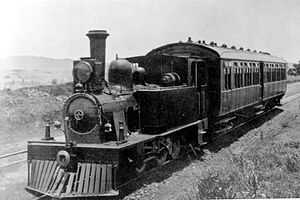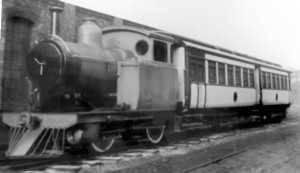CSAR Railmotor
| CSAR Railmotor | |
|---|---|
|
CSAR Railmotor no. M2, c. 1907 | |
| Type and origin | |
| Power type | Steam |
| Designer | Kitson and Company |
| Builder |
Engine: Kitson and Company Coach: Metropolitan Amalgamated Railway Carriage & Wagon |
| Serial number | 4410 |
| Build date | 1906 |
| Total produced | 1 |
| Specifications | |
| Configuration | 0-4-0T+4 |
| AAR wheel arr. | B-2 |
| Gauge | 3 ft 6 in (1,067 mm) Cape gauge |
| Driver diameter | 39 in (0.991 m) |
| Trailing wheel diameter | 33 1⁄2 in (0.851 m) |
| Wheelbase |
8 ft (2.438 m) coupled 6 ft 5 in (1.956 m) bogie 52 ft 8 1⁄2 in (16.066 m) total |
| Length |
62 ft 1⁄2 in (18.910 m) over beams 46 ft 11 in (14.300 m) coach |
| Width |
Engine 7 ft 5 in (2.261 m) over running boards 8 ft 7 in (2.616 m) over cab Coach 9 ft 1 3⁄4 in (2.788 m) over body 8 ft 4 in (2.540 m) over footsteps |
| Height | 11 ft 9 in (3.581 m) |
| Axle load |
13 9⁄20 long tons (13.7 t) per driver 10 6⁄20 long tons (10.5 t) per bogie axle |
| Locomotive weight |
35 long tons (35.6 t) empty 47 long tons (47.8 t) w/o |
| Fuel type | Coal |
| Fuel capacity | 1 long ton (1.0 t) |
| Water capacity | 500 imp gal (2,300 l) |
| Boiler |
3 ft 8 in (1.118 m) outside diameter 6 ft (1.829 m) inside length 7 ft (2.134 m) pitch |
| Boiler pressure | 160 psi (1,100 kPa) |
| Firegrate area | 10.75 sq ft (0.999 m2) |
| Heating surface: – Tubes |
180 tubes 1 5⁄8 in (41.3 mm) diameter 459 sq ft (42.642 m2) |
| – Firebox | 50.5 sq ft (4.692 m2) |
| – Total | 510 sq ft (47.381 m2) |
| Cylinders | Two |
| Cylinder size |
11 in (279 mm) bore 16 in (406 mm) stroke |
| Performance figures | |
| Tractive effort | 6,354 lbf (28 kN) at 75% pressure |
| Career | |
| Operator(s) |
Central South African Railways South African Railways [1] |
| Class | Railmotor |
| Number in class | 1 |
| Number(s) | M2 |
| Delivered | 1907 |
| First run | 1907 [2] |
| Withdrawn | c. 1921 [3] |
The CSAR Railmotor of 1907 is a South African steam railmotor locomotive from the pre-Union era in the Transvaal.
In 1907 the Central South African Railways acquired a single self-contained Railmotor for the low-volume railmotor passenger service that had been introduced the previous year. The predecessor vehicle was a railmotor engine that consisted of a single 19 Tonner 0-4-2T locomotive, modified and semi-permanently coupled to a modified 3rd Class side-door passenger coach that was equipped with a driving cab at the rear. On the new railmotor the passenger coach was an integral part of the locomotive itself.[2][3][4]
Railmotor service
In January 1905 an order had been placed by the Central South African Railways (CSAR) with Kitson and Company for two self-contained railmotors, of which only one was eventually delivered in 1907. While awaiting delivery, it was decided to construct a railmotor engine at the Pretoria Works, consisting of a light 19 Tonner 0-4-2T locomotive and a fifty-two seat side-door 3rd Class suburban coach. The locomotive was modified and semi-permanently coupled to the coach, which was modified to contain a driving cab at the rear end, with the controls arranged so that the push-pull unit could be driven from either vehicle. The locomotive was reclassified as a Railmotor Engine and renumbered M1. The CSAR railmotor service was put into operation in April 1906 and operated between Rissik in Johannesburg and Wonderboom in Pretoria.[2][3][4]
Manufacturer

The single new Kitson-built Railmotor was delivered in early 1907 and was numbered M2. It was a self-contained motor-coach with a fifty-six seat capacity, in which the engine, boiler and coach were embodied in a single vehicle. While the engine part of the vehicle was built by Kitson, the coach part was constructed by Metropolitan Amalgamated Railway Carriage & Wagon. To negotiate curves and points, the power unit was not rigid and pivoted like a bogie. The railmotor was erected at the Salt River shops of the Cape Government Railways (CGR) in Cape Town and entered service on the CSAR on 10 August 1907.[2]
Service
Central South African Railways
Railmotor no. M2 initially worked out of Germiston on the Elsburg-Germiston-Rietfontein Mine route, but the service was extended on 8 September 1907 to include the Germiston-Jupiter section. The route of the home-built railmotor engine no. M1 was also extended to Hatherley-Rissik-Pretoria-Wonderboom.[2]
In service, the new railmotor no. M2 was found to be less satisfactory than the home-built railmotor engine no. M1, which was considered to be superior in aspects like design, passenger comfort, economy in running and convenience in working. Since the imported railmotor was a single vehicle, the carriage was unusable while the engine had to be withdrawn for service or repairs. The Pretoria-built coach was still readily detachable from the locomotive and both engine and coach were still complete units which could be used independently of each other.[2]
The purchase cost of railmotor no. M2 was £4,654, while the cost to convert the first 19 Tonner and a coach to a railmotor engine had been £5,827. Given the advantages of the home-built vehicle over the imported railmotor and the fact that several 19 Tonners were standing idle and considered unusable for any other purpose, no more railmotors were ordered and another two 19 Tonners were converted to railmotor engines in 1908, at a cost of £2,485 each. During 1909 orders were placed with the shops for another seven railmotor engines. These nine vehicles were renumbered in the range from M3 to M11.[2]

Between 1906 and 1909 steam railmotor services were expanded to operate on four routes:[2][3][4]
- Hatherley-Pretoria-Wonderboom.
- Elsburg-Germiston-Rietfontein Mine.
- Luipaardsvlei-Krugersdorp-Randfontein.
- Germiston-Geduld.
South African Railways
The Union of South Africa was established on 31 May 1910, in terms of the South Africa Act, enacted by the Parliament of the United Kingdom. One of the clauses in the Act required that the three Colonial Government railways, the CGR, the Natal Government Railways and the CSAR, also be united under one single administration to control and administer the railways, ports and harbours of the Union. While the South African Railways (SAR) came into existence in 1910, the actual classification and renumbering of all the rolling stock of the three constituent railways required careful planning and was only implemented with effect from 1 January 1912.[5][6]
In 1912 the railmotor, along with the ten railmotor engines, were taken onto the SAR roster as unclassified locomotives since they were considered obsolete. Since they were excluded from the SAR renumbering schedules, they retained their CSAR engine numbers.[6]
At some stage the railmotor's boiler was allocated SAR boiler number 4001. It was withdrawn from service by 1921.[3][4]
See also
- List of South African locomotive classes
- South African locomotive history
- NZASM 19 Tonner 0-4-2T
- The 0-4-0 wheel arrangement
References
|
- ↑ CSAR no. 2 Motor Coach diagram
- ↑ 2.0 2.1 2.2 2.3 2.4 2.5 2.6 2.7 CSAR General Manager's Reports, Extracts from the CSAR General Manager's Reports for 1906, 1907, 1908 & 1909.
- ↑ 3.0 3.1 3.2 3.3 3.4 Paxton, Leith; Bourne, David (1985). Locomotives of the South African Railways (1st ed.). Cape Town: Struik. p. 24. ISBN 0869772112.
- ↑ 4.0 4.1 4.2 4.3 19 Tonner Information supplied by John Nicholas Middleton
- ↑ The South African Railways - Historical Survey. Editor George Hart, Publisher Bill Hart, Sponsored by Dorbyl Ltd., Published c. 1978.
- ↑ 6.0 6.1 Classification of S.A.R. Engines with Renumbering Lists, issued by the Chief Mechanical Engineer’s Office, Pretoria, January 1912, p. 2 (Reprinted in April 1987 by SATS Museum, R.3125-6/9/11-1000)
